What Is A Stye?
A stye is an infection of one or more oil glands in the eyelid. It usually appears as a red bump or pimple-like swelling at the base of an eyelash, although it can sometimes occur on the inside of the lid near the tear ducts. Symptoms include pain, tenderness, redness, and swelling around the affected area. Styes typically go away within several days without treatment but can be very uncomfortable and unsightly during this time.
Can I Get Eyelash Extensions If I Have A Stye?
The short answer is no – having a stye means that it’s not safe to get eyelash extensions at this time. When applying lashes, technicians use tweezers and glue to attach individual lashes onto each natural lash in order to create a fuller look. Because styes involve inflamed oil glands in the eyelids, they increase your risk of infection if any bacteria gets into those areas during the application or removal of lashes. As such, most lash technicians won’t apply lashes if there’s any sign of infection present in order to protect their clients from further irritation or possible complications due to bacteria entering open wounds created by infected oil glands near where they would be attaching lashes with tweezers and glue.
Additionally, even after treating a stye with antibiotics or home remedies such as warm compresses or topical ointments (if recommended by your doctor), it’s important for individuals with a recent history of eye infections like these not to put themselves at further risk by getting fake eyelashes applied too soon after healing has occurred. Doing so could potentially cause additional irritation and introduce new bacteria into already sensitive areas around their eyes, which could lead to more serious complications like conjunctivitis (pink eye) or blepharitis (inflammation along the inner lining of the upper and lower lids). If you notice excessive shedding, clumping, or a mismatched appearance of your eyelash extensions, it could be a failed eyelash extensions sign, indicating poor application or low-quality adhesive.
Other Eye Conditions To Consider
In addition to avoiding lash services when suffering from an active infection such as styes or chalazions (cysts caused by blocked gland openings), individuals should also avoid getting fake lashes applied when experiencing other types of allergies that might affect their eyes, such as allergic conjunctivitis (an allergic reaction affecting the tissue surrounding the eyeball). Reactions like these could result in severe irritation, which may lead to further problems due to greater exposure to the harsh chemicals used during the application process, like formaldehyde found in some adhesives used for attaching false lashes to real ones. This, in turn, increases the risks associated with bacterial infections along the entire area surrounding delicate parts, including both upper and lower lids, as well as the sensitive corneas located underneath the protective layers made up of both skin and mucous membranes that cover the outer portion of these structures, protecting our vision centers.
It’s also important to keep in mind that people with existing eye conditions such as dry eyes, blepharitis, or any other type of infection should avoid eyelash extensions and opt for a lash lift instead. A lash lift is a semi-permanent treatment that uses perming solutions to curl your natural lashes without the need for any glue or false lashes.

In conclusion, it is not recommended to get eyelash extensions if you have a stye on your eye, eyelash extensions may aggravate the problem and affect vision. Styes are infections of the oil glands in the eyelid, which increase your risk of further irritation or infection when applying fake lashes. Additionally, individuals should also avoid getting fake lashes applied when experiencing other types of allergies that might affect their eyes, such as allergic conjunctivitis, since reactions like these could result in severe irritation that may lead to further problems due to greater exposure to the harsh chemicals used during the application process. It’s best to wait until after treating an active infection before considering getting lash services done again, and always make sure you do proper research about salon safety protocols prior to booking an appointment with a certified technician.

